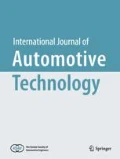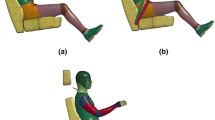Abstract
Neck fracture is a major cause of death in traffic accidents. This pattern of injury normally occurs in a frontal collision or overturn of a vehicle. This study investigates the case of a neck fracture from a low-speed collision. In the examined case, the passenger in the front seat of the car fractured his neck and died. He did not have his seatbelt on when the vehicle slipped on a frozen road surface on a downward slope of a hill and impacted into the shoulder of the road at low speed. In this type of collision, an occupant’s body will be impacted by the windshield or other interior trim of the car. However, in this case, rather unusually, neither body tissue nor fiber remained although the collision involved a broken windshield. Thus, the reason for the passenger death was unidentified. This study applied the computer simulation package Madymo for analyzing the accident. The result of the simulation was that the passenger, who did not wear a seatbelt, moved forward due to inertia. The upper part of the passenger then rotated and lifted when the knee contacted with the dashboard. By evaluating the structural deformation of the vehicle at the front, we deduced that the collision velocity was 30 km/h. Through a computational experiment that was undertaken using Madymo 7.0, NIC was estimated to be 240 m2/s2. This result far exceeded the threshold for neck injuries. In particular, in comparison with whiplash injuries, when the passenger’s head directly impacts the roof following a rear-end collision, the bending moment through hyperextension of the neck is greatly increased. In this study, we concluded that the manner of death was the hyperextension of the neck, as the passenger’s head contacted the roof from underneath.
Similar content being viewed by others
References
Balažic, J., Prebil, I. and Čertanc, N. (2006). Computer simulation of the accident with nine victims. Forensic Science Int., 156, 161–165.
Campbell, K. L. (1974). Energy basis for collision severity. SAE Paper No. 740565.
Cory, C. Z. and Jones, M. D. (2006). Development of a simulation system for performing in situ surface tests to access the potential severity of head impacts from alleged childhood short falls. Forensic Science Int., 163, 102–114.
Croft, A. C., Herring, P., Freeman, M. D. and Haneline, M. T. (2002). The neck injury criterion: future considerations. Accident Analysis and Prevention, 34, 247–255.
Ermenc, B. and Prijon, T. (2005). Suicide, accident? The importance of the scene investigation. Forensic Science Int. 147S. S21–S24.
Kaneko, N., Wakamatsu, M., Kukushima, M. and Ogawa, S. (2004). Study of bioRID II sled testing and MADYMO simulation to seek the optimized seat characteristics to reduce whiplash injury. SAE Paper No. 2004-01-0336.
Lezeau, T. and Nazat, D. (2004). Crime scene analysis: Daily approach in a French research section. Forensic Science Int. 146S, S29–S30.
McConnell, W. E., Howard, R. P., Poppel, J. V., Krause, R., Guzman, H. M., Bomar, J. B., Raddin, J. H., Benedict, J. V. and Hatsell, C. P. (1995). Human head and neck kinematics after low velocity rear-end impacts-understanding “Whiplash”. SAE Paper No. 952724.
Nightingale, R. W., Winkelstein, B. A., Knaub, K. E., Richardson, W. J., Luck, J. F. and Myers, B. S. (2002). Comparative strengths and structural properties of the upper and lower cervical spine in flexion and extension. J. Biomechanics, 35, 725–732.
O’Riordain, K., Thomas, P. M., Phillips, J. P. and Gilchrist, M. D. (2003). Reconstruction of real world head injury accident resulting from falls using multibody dynamics. Clinical Biomechanics, 18, 590–600.
TNO Automotive (2008). MADYMO Model Manual Version 7.0.
Yoganandan, N., Pinter F. A., Stemper, B. D., Schlick, M. B., Philippens, M. and Wismans, J. (2000). Biomechanics of human occupants in simulated rear crashes: Documentation of neck injuries and comparison of injury criteria. SAE Paper No. 2000-01-SC14.
Zuby, D. S., Vann, D. T., Lund, A. K. and Morris, C. R. (1995). Crash test evaluation of whiplash injury risk. SAE Paper No. 95SC17.
Author information
Authors and Affiliations
Corresponding author
Rights and permissions
About this article
Cite this article
Park, S.J., Chae, S.W. & Kim, E.S. Analysis of neck fractures from frontal collisions at low speeds. Int.J Automot. Technol. 11, 441–445 (2010). https://doi.org/10.1007/s12239-010-0054-9
Received:
Revised:
Published:
Issue Date:
DOI: https://doi.org/10.1007/s12239-010-0054-9




